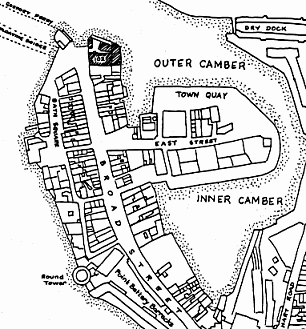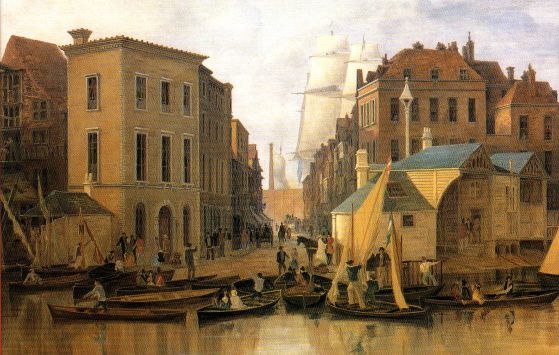

In 1985 Cynthia Sherwood attended a local history class run by the University of the Third Age and came away inspired to investigate the origins of the house in which she had lived between 1935 and 1951. This was no ordinary house in that it was at 102 Broad Street and had every right to be referred to as "The last house in Portsmouth" being at the very end of Broad Street, overlooking the mouth of the Camber.
Over the following years Cynthia's research grew until she had a comprehensive history of the house and the land upon which it stood from 1656 until the time it was demolished in 1960. There is no detailed evidence available to describe the environment at the end of Point before 1656, but as the town had been established some 500 years earlier it is certain that it was occupied in some manner.
------------------------------------------------------------------
In The Beginning
The first documentary evidence comes from the mid 17C when, "a seller of strong waters" named Nicholas Peirson was granted a piece of Beach ground:-
"Grant in fee the twentieth day of June AD 1656 made by John Tawke Esq. Mayor of the Borough of Portsmouth and the Aldermen and Burgesses of the same Borough to Nicholas Peirson a piece of Beach ground whereupon he hath built a wharf and two storehouses lying without the Point Gate at Portsmouth aforesaid near the new quat erecting there and containeth in length on the West side seventy-three feet, in length on the East side, sixty-seven feet, in breadth at the North fifty-seven feet, in breadth at the South side forty-seven feet......unto the said Nicholas Peirson his heirs and assigns for ever under the yearly rent of six shillings and eightpence payable at Michaelmas and on Lady Day and also one fat turkey at St. Thomas the Apostle..."
Robert East's "Extracts from the Portsmouth Records" tells us that "Nicholas Peirson was a wealthy shipowner, he resided at the extremity of the Point, where the Star and Garter and Baker's Wharf now stand". He owned considerable property, was made a Burgess in 1645 and in 1653 issued tokens bearing his name to serve as farthings. In 1670 he was made an Alderman and in 1672 became Mayor of Portsmouth. He died in 1677 and was buried on 29th June in St. Thomas' Churchyard.
The Board of Ordnance
The old maps of Portsmouth clearly show that the "House on the Point" stood on an important site at the entrance to the Camber, and that it would have been an ideal position for a wharf and storehouse for the Board of Ordnance and on a town plan of 1716 the words "Ordnance Wharfe" are written against the property. Robert East confirms this with the following entry in his "Extracts..."
"The Ordnance office and wharf were originally at the North end of the Point, since Lindegren's Wharf (now Threadingham's)...."
There is a record that on 20th March 1676 the property belonging to Nicholas Peirson was leased to the office of His Majesty's Ordnance for 99 years.
At Priddy's Hard Museum in Gosport there is stored a considerable amount of correspondence from the London office of the Board of Ordnance to Portsmouth, most of the early letters being addressed to "Mr. Hooper, Storekeeper to ye Office of Ordnance at Portsmouth." One letter dealt with an incident at the stores upon which Mr. Hooper had written that it related to the Point Wharfe thus confirming that the House at Point and the Board of Ordance store were parts of the same property.
When the house was demolished in 1960 there were found to be arched vaults and stores with very solid walls beneath it that could well date from the period in question. A plan of the property completed in the 1950s shows all the faults and fractures in the arches.
As early as 1699 there was concern about the unsuitability of the Point site, mainly because of the lack of water at low tide. It may well have been this factor that caused the Board to begin planning the construction of the new Gunwharf on the other side of the Camber. John Hooper was by this time rather elderly and was not appointed as Storekeeper to the new stores at Gunwharf but continued to live in a house rented by His Majesty's Service. He died in 1723 and was buried on 30th January in St. Thomas' Churchyard.
The Dark Years
After the Ordnance stores had been removed to the Gunwharf the vacant property was leased, on 29th September 1724 to Benjamin Whiteing. The lease was for 300 years at an annual rent of £1 2s 6d and two couple of good fat capons. The property was described as being known as Peirson's Quay which was bounded on the south by Thomas Hunt's storehouse and on the west by the house of Nicholas Peirson the Younger. The property now occupied some 8,800 square feet, somewhat larger than defined in the original lease. The Younger Nicholas Peirson also went on to become Mayor of Portsmouth (1682) and died in 1685/86.
Benjamin Whiteing (or Whiting) lived on in the property until about 1730 during which time his son, also called Benjamin, worked as an apprentice Shipwright. This may have been the reason why, on his father's death, the younger Nicholas did not take up residence in the house. Instead it was rented to Joseph Gilbert, a victualler and a Constable of the Town. The rental on the house then seems to have passed through a number of occupants including Mrs. Eleanor Gayton and family (1732), Rebecca Tooley (1745), Peter Ireland (1746) and Banister Hurst (1749). After this time Benjamin Whiteing returned to the house, dying there in 1777; his widow continuing to reside there until about 1782.
By 1783 the house had passed into the ownership of Andrew Lindegren Jnr., possibly through an association with the Whiteing family, but the process was not smooth. Although his "Wharf, Office and Store" appear in the Rate Book of that year, a report in the Salisbury and Winchester Journal for 29th December 1783 announced the bankruptcy of Andrew Lindegren and listed the Broad Street properties amongst his assets. Somehow though, the Lindegren family held onto the house as well as several other buildings in the Town of Portsmouth and beyond. Their business flourished thereafter.
Into the 19th Century
There occurred on Saturday 24th June 1809 one of the most dramatic incidents in the history of the house. Two or three days earlier the 2nd Battalion of the 8th Regiment of Foot had disembarked at Point leaving their baggage, including munitions, on the beach. That morning a few soldiers were arranging for the removal of their possessions when a women, who was smoking a pipe invited another, doing her washing at the water's edge to take a whiff. Finding it would not draw she tapped the pipe against a pebble on the beach and a spark ignited a few grains of powder. Within seconds this had led to a massive explosion as the flames reached several barrels of gunpowder. The Hampshire Telegraph reported:-
The explosion set fire to Mr. Lindegren's store, broke all the windows, and many of the window frames, of the Star and Garter, Mr. Lindegren's office and Navy Post Office, and upwards of 20 other house on the street. The number of lives that were lost and of persons wounded from the instantaneous nature of the incident cannot be certainly ascertained. Three soldiers of the 8th Regiment who were standing about the baggage were killed; four were badly and five slightly burned....several of the soldiers wives and children are believed to have lost their lives"
There were reports of bodied being flung over the tops of houses whilst one man was thrown against the wall of the Union Tavern near the first floor window badly staining the bricks with blood. At least 17 people are thought to have been killed though there may have been more whose bodies were thrown into the sea. Amazingly the woman who caused the blast survived with minor injuries.
Lindegren's store was reputed to have held gunpowder casks but if so then they did not explode and business would have soon returned to normal.
In 1827 Andrew Lindegren Jnr. died and was succeeded by his son John who in turn proved to be a most able businessman.
The Floating Bridge
In one of his financial ventures John Lindegren became, in 1838, a subscriber and Director of the Floating Bridge Company which was formed to create a better link between Portsmouth and Gosport which hitherto had only been able to carry foot passengers. Point was chosen to be the Portsmouth end of the service but the area would need redeveloping in order to accomodate it. In particular, 32 feet from the front of Lindegren's store was purchased and an order in Parliament was secured to compulsorily purchase the living quarters which at that time stretched halfway across Broad Street.

The artist R.H.C. Ubsdell wrote at the time to Sir Frederick Madden that:-
"...the house at the lower end of point, so many years occupied by Mr. Lindegren and which Parliament has ordered to be pulled down has been demolished today which gives an open view of the harbour looking down Broad Street......on crossing from Gosport to Point we have a view of the Star and Garter Hotel and several houses up the street."
This demolition of the original property signalled a marked improvement in the social conditions in the area. Soon, the living quarters on the Point property were rebuilt in the newer and grander style that can be seen in an 1860 painting of Point, called 'The Quebec Hotel' by E.W. Cooke R.A. (see below). For some reason though, Lindegren sold the property shortly afterwards to Andrew Nance Jnr., a co-director of the Floating Bridge Company. Nance did not however live at the house but instead rented it to George Baker Jnr. who, ten years later, purchased it from Nance. Baker too, had proved adept at business and had earned enough money by 1857 to enable him to buy the Star and Garter Hotel next door.
George Baker was now wealthy enough to move to the newly fashionable area of Elm Grove in 1861, where he lived near the Lindegren family, at Elm Lodge. The Point House was let to Elizabeth Main who did not stay long as she died in 1863 leaving the house to remain unoccupied for two years. During this time Baker, who had decided to retire, tried to sell the property to the Corporation who declined for financial reasons. Fortunately for Baker, the Port of Portsmouth and Ryde United Steam Packet Company were in need of new premises so in 1865 they bought the property and moved their new Superintendent, Mr. Henry Threadingham, into the accommodation.
